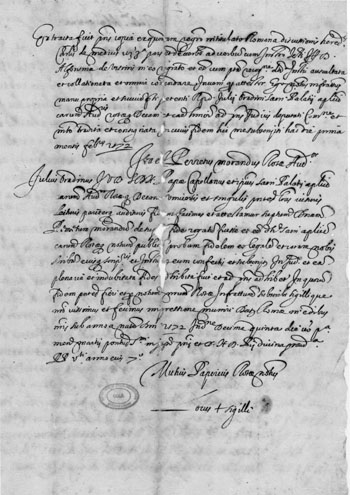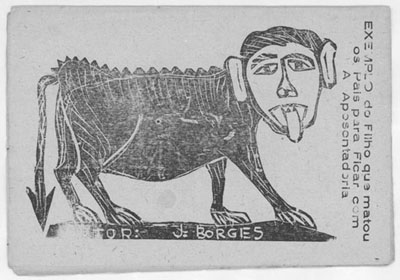
East Asia | Europe | Latin America | Near East
|
Will of Alphonsina Orsini. 1520. 4 leaves. Holograph. Scanned
copy of signature leaf. In: Orsini family. Collection of material about
the Orsini family, 1200 - 1929. Collection 902 Box 240
Other documents showing the Orsini women's importance and influence include a one leaf proxy by Francesca Orsini, 1516, and the dowry of Clarice Orsini, 1535. |  |
| [José Francisco Borges], author and illustrator. Exemplo do Filho que matou os Pais para Ficar com A Aposentadoria. Olinda, Brazil? No date. 1970s? Also shown: other literatura de cordel selections. In: a Collection of literatura de cordel, ca. 1970 - 1995. Collection 1420. Box 1 f.3 | |
 |
The genre translates as "stories on a string." These chapbooks are inexpensively produced in the northeast states of Brazil. The folhetos (pamphlets) can be hung on a cordel (string) to be sold. They relate populist imagery of romance and crime and cover illustrations are often in woodblock. They are roughly related to the stories and imagery of Posada and continue to this day. This example is a news folheto, about a member of a family who turns murderer. The title translates: The Example of the Son Who Murdered His Parents in Order to Get His Hands on Their Retirement Benefits. |
Near East
Collections supporting Near Eastern Studies include approximately 15,000
manuscripts, with catalogues, in Arabic, Persian, and Turkish, primarily in
the fields of literature, philology, theology, law, and history, and ranging
from the 11th through the 19th centuries. The department holds Dr. Caro Minasian's
library, a collection of Armenian religious manuscripts dating from the 14th
century. Among printed materials are fine press editions and translations
of the Persian poet-philosopher Omar Khayyam, limited edition facsimiles of
illuminated Arabic manuscripts, and historical editions and versions in European
languages of the Arabian Tales of the 1001 Nights.
The collections are also supported by more than
Sir Richard Francis Burton, 1821 - 1890. The Sotadic Zone.
New York: Privately printed by the Panurge Press, 1930? This edition is
limited to two thousand and ten copies, ten copies of which are for the
editors of the Panurge Press. Special Collections copy: No.597. Special
Collections SRLF
Printings of "The Sotadic Zone" are oddities produced from Burton's
translation of The One Thousand Nights and One Night. For the Benares
Edition of the 1001 Nights, he wrote a "Terminal Essay," then repressed,
but later often printed with this title. Another example in the Dept.
is entitled Anthropological Notes on the Sotadic Zone of Sexual Inversion:
Including Some Observations on Social and Sexual Relations of the Mohammedan
Empire. (New York: Privately issued by Falstaff Press, ca. 1930?).
This was not Burton's title at all, and he worked before there was a discipline
called anthropology. But in this comparative essay he proposed a theory
of same sex activity, supposedly more prevalent in areas of what he termed
the Sotadic Zone, comprising many places where Burton himself traveled
and lived. He defined these as primarily tropical, but areas such as Alaska
were included, all "non Western." It is possible that some of this is
to be taken tongue in cheek, although there is no certainty of it from
his tone. Many later writers would refer to his ideas and research, for
example, J. A. Symonds in Problem in Greek Ethics.


References
References 
